Process Parameters Optimization of One-Step Spin Forming of Top Cover with Center Flanged Hole
Abstract
:1. Introduction
2. One-Step Method for Marginal-Restraint Mandrel-Free Spinning of Top Covers with Center Flanged Holes
3. Development and Verification of the Finite Element Model (FEM)
3.1. Development of the FEM
3.2. Verification of the FEM Model
4. Results and Discussion
4.1. Influence of Roller Trajectory on Forming Quality
4.2. Influence of Feed Ratio on Forming Quality
4.3. Influence of Roller Fillet Radius on Forming Quality
4.4. Experimental Verification
5. Conclusions
Author Contributions
Funding
Institutional Review Board Statement
Informed Consent Statement
Data Availability Statement
Conflicts of Interest
References
- Music, O.; Allwood, J.M.; Kawai, K. A review of the mechanics of metal spinning. J. Mater. Process. Technol. 2010, 210, 3–23. [Google Scholar] [CrossRef]
- Markus, B.; Holger, V.; Gerhard, H. A New Process Design for Performing Hole-flanging Operations by Incremental Sheet Forming. Procedia Eng. 2014, 281, 2305–2310. [Google Scholar] [CrossRef]
- Zhang, Y.Q.; Shan, D.B.; Xu, W.C.; Lv, Y. Study on Spinning Process of a Thin-Walled Aluminum Alloy Vessel Dome With Small Ratio of Thickness to Diameter. J. Manuf. Sci. Eng. 2010, 132, 014504. [Google Scholar] [CrossRef]
- Li, Z.X.; Zhan, M.; Fan, X.G.; Dong, Y.D.; Xu, L.P. Effect of blank quenching on shear spinning forming precision of 2219 aluminum alloy complex thin-walled components. Chin. J. Aeronaut. 2022, 36, 538–555. [Google Scholar] [CrossRef]
- Chen, S.W.; Zhan, M.; Gao, P.F.; Ma, F.; Zhang, H.R. A new robust theoretical prediction model for flange wrinkling in conventional spinning. J. Mater. Process. Technol. 2021, 288, 116849. [Google Scholar] [CrossRef]
- Yu, Z.; Zhao, Y.; Du, C.; Liu, D.F.; Evsyukov, S.A. Study on flange-constrained spinning process for hemispherical aluminum alloy part. J. Mater. Process. Technol. 2020, 278, 116515. [Google Scholar] [CrossRef]
- Gan, T.; Jun, N.; Yu, Z.Q.; Zhao, Y.X.; Li, S.H. Study on warm formability of aluminum alloy 2219 in hemispherical part conventional spinning. Procedia Manuf. 2020, 50, 45–50. [Google Scholar] [CrossRef]
- Watson, M.; Long, H. Wrinkling Failure Mechanics in Metal Spinning. Procedia Eng. 2014, 81, 2391–2396. [Google Scholar] [CrossRef]
- Zhang, H.R.; Zhan, M.; Zheng, Z.B.; Li, R.; Ma, F.; Cui, X.; Chen, S.; Lei, Y. Forming dependence on spin roller paths for thin-walled complex components from 2195 Al-Li alloy TWBs. Int. J. Adv. Manuf. Technol. 2022, 120, 3113–3122. [Google Scholar] [CrossRef]
- Zhan, M.; Yang, H.; Zhang, J.H.; Xu, Y.L.; Ma, F. 3D FEM analysis of influence of roller feed rate on forming force and quality of cone spinning. J. Mater. Process. Technol. 2007, 187, 486–491. [Google Scholar] [CrossRef]
- Rao, G.J.; Li, X.H.; Zhou, L.; Chang, S.W.; Cao, Q.; Yi, Z.X. A multi-constraint spinning process of ellipsoidal domes. Int. J. Adv. Manuf. Technol. 2018, 94, 1505–1512. [Google Scholar] [CrossRef]
- Liu, B.M.; Gao, S.; Jia, Z.; Wen, Y.Z.; Han, Z.R.; Gong, X. Non-axisymmetric die-less spinning using ball-crown-shape roller. Manuf. Process 2022, 79, 70–80. [Google Scholar] [CrossRef]
- Lin, Y.C.; Chen, J.Y.; He, D.G.; Li, X.H.; Yang, J. Marginal-restraint mandrel-free spinning process for thin-walled ellipsoidal domes. Adv. Manuf. 2020, 8, 189–203. [Google Scholar] [CrossRef]
- Jia, Z.; Ye, T.; Han, Z.; Han, Z.R.; Xiao, Y.; Ji, S.D. Study on die-less spinning of cone–cylinder combined hollow parts. J. Mater. Process. Technol. 2019, 271, 488–498. [Google Scholar] [CrossRef]
- Li, L.B.; Chen, S.Y.; Lu, Q.Y.; Shu, X.D.; Zhang, J.; Shen, W.W. Effect of Process Parameters on Spinning Force and Forming Quality of Deep Cylinder Parts in Multi-Pass Spinning Process. Metals 2023, 13, 620. [Google Scholar] [CrossRef]
- Peng, H.L.; Li, M.Z.; Liu, C.G.; Fu, W.Z.; Cao, J.H. Numerical simulation of multi-point forming accuracy for polycarbonate sheet. Arch. Proc. Inst. Mech. Eng. Part E J. Process Mech. Eng. 2013, 228, 87–96. [Google Scholar] [CrossRef]
- Xia, Q.X.; Xiao, G.F.; Long, H.; Cheng, X.Q.; Sheng, X.F. A review of process advancement of novel metal spinning. Int. J. Mach. Tools Manuf. 2014, 85, 100–121. [Google Scholar] [CrossRef]
- Huang, K.; Yi, Y.P.; Huang, S.Q.; He, H.L.; Dong, F.; Jia, Y.Z.; Yu, W.W. Cryogenic die-less spinning of aluminum alloy thin-walled curved components and microstructure evolution. J. Manuf. Process. 2023, 92, 32–41. [Google Scholar] [CrossRef]
- Yan, X.G.; Zhan, M.; Wang, Y.; Gao, P.F.; Wang, Y.D. Criterion and processing-dependence of forming states in the die-less spinning of conical part. Int. J. Adv. Manuf. Technol. 2023, 125, 3037–3051. [Google Scholar] [CrossRef]
- Krichen, A.; Kacem, A.; Hbaieb, M. Blank-holding effect on the hole-flanging process of sheet aluminum alloy. J. Mater. Process. Technol. 2011, 211, 619–626. [Google Scholar] [CrossRef]
- Ou, H.; Sun, S.J.; Li, P.F.; Li, G.Y.; Cui, J. A dynamic small-sized hole flanging process driven by Lorentz-force for aluminum alloys. Int. J. Mater. Form. 2021, 14, 1019–1030. [Google Scholar] [CrossRef]
- Yogesh, D.W.; Rajesh, P.; Nitin, T. A study on sheet metal hole-flanging process. Mater. Today 2017, 4, 5421–5428. [Google Scholar] [CrossRef]
- Li, M.; Lai, Z.P.; Xu, W.; Zheng, Y.; Zhang, Z.X.; Li, C.X.; Gao, Y.H.; Wang, Z.Y.; Cao, Q.L.; Han, X.T.; et al. A versatile electromagnetic actuator for sheet and tube flanging: Process principle, simulation, and experimental validation. J. Manuf. Process. 2022, 81, 311–327. [Google Scholar] [CrossRef]
- Su, H.L.; Huang, L.; Li, J.; Li, J.J.; Ma, F.; Ma, H.J.; Huang, P.; Zhu, H.; Feng, F. Inhomogeneous deformation behaviors of oblique hole-flanging parts during electromagnetic forming. J. Manuf. Process. 2020, 52, 1–11. [Google Scholar] [CrossRef]
- Thipprakmas, S.T.; Jin, M.; Murakawa, M. Study on flanged shapes in fineblanked-hole flanging process (FB-hole flanging process) using finite element method (FEM). J. Mater. Process. Technol. 2007, 192, 128–133. [Google Scholar] [CrossRef]
- Cui, Z.; Gao, L. Studies on hole-flanging process using multistage incremental forming. CIRP J. Manuf. Sci. Technol. 2010, 2, 124–128. [Google Scholar] [CrossRef]
- Centeno, G.; Silva, M.B.; Cristino, V.A.M.; Vallellano, C.; Martins, P.A.F. Hole-flanging by incremental sheet forming. Int. J. Mach. Tools Manuf. 2012, 59, 46–54. [Google Scholar] [CrossRef]
- Elmasry, M.; Elmetwally, H.T.; El-Sheikh, M.N.; Abdel-Magied, R.K. An experimental and analytical investigation of flange forming by spinning process. J. Comput. Appl. Res. Mech. Eng. (JCARME) 2021, 11, 35–46. [Google Scholar] [CrossRef]
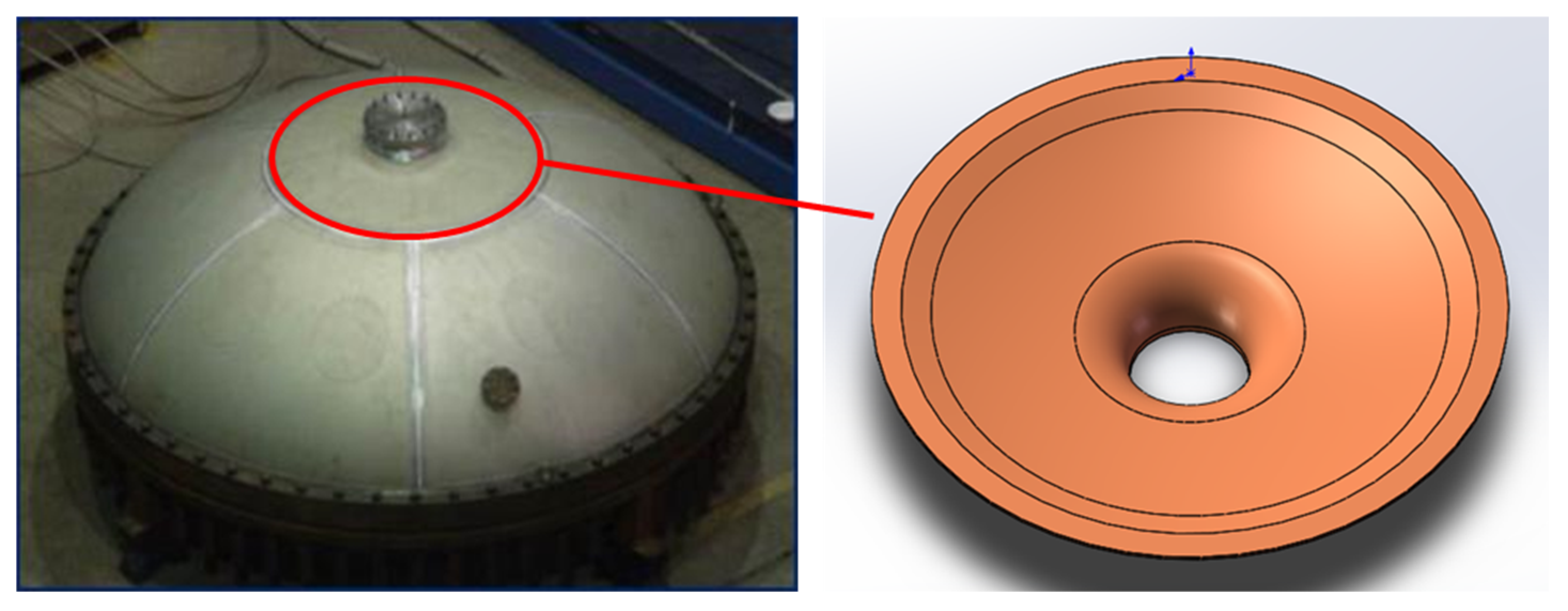
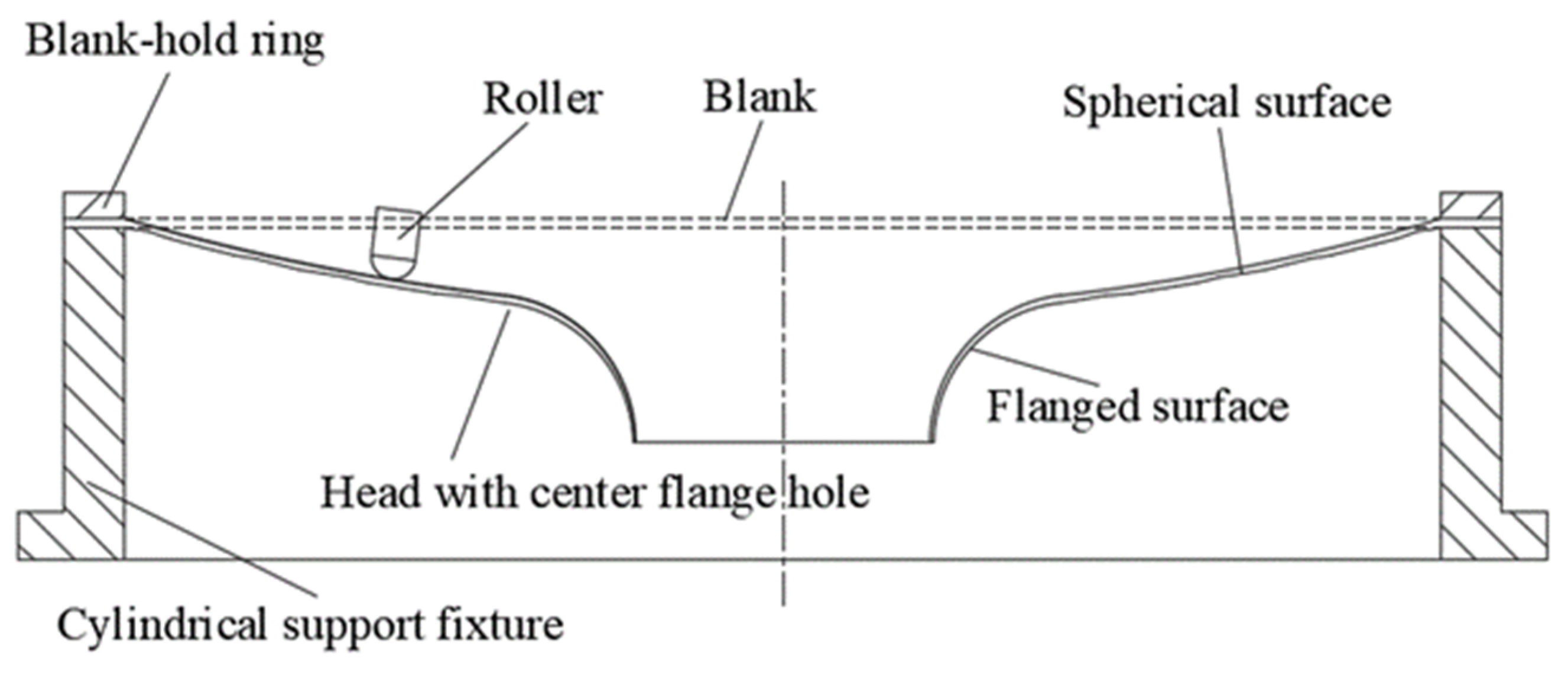
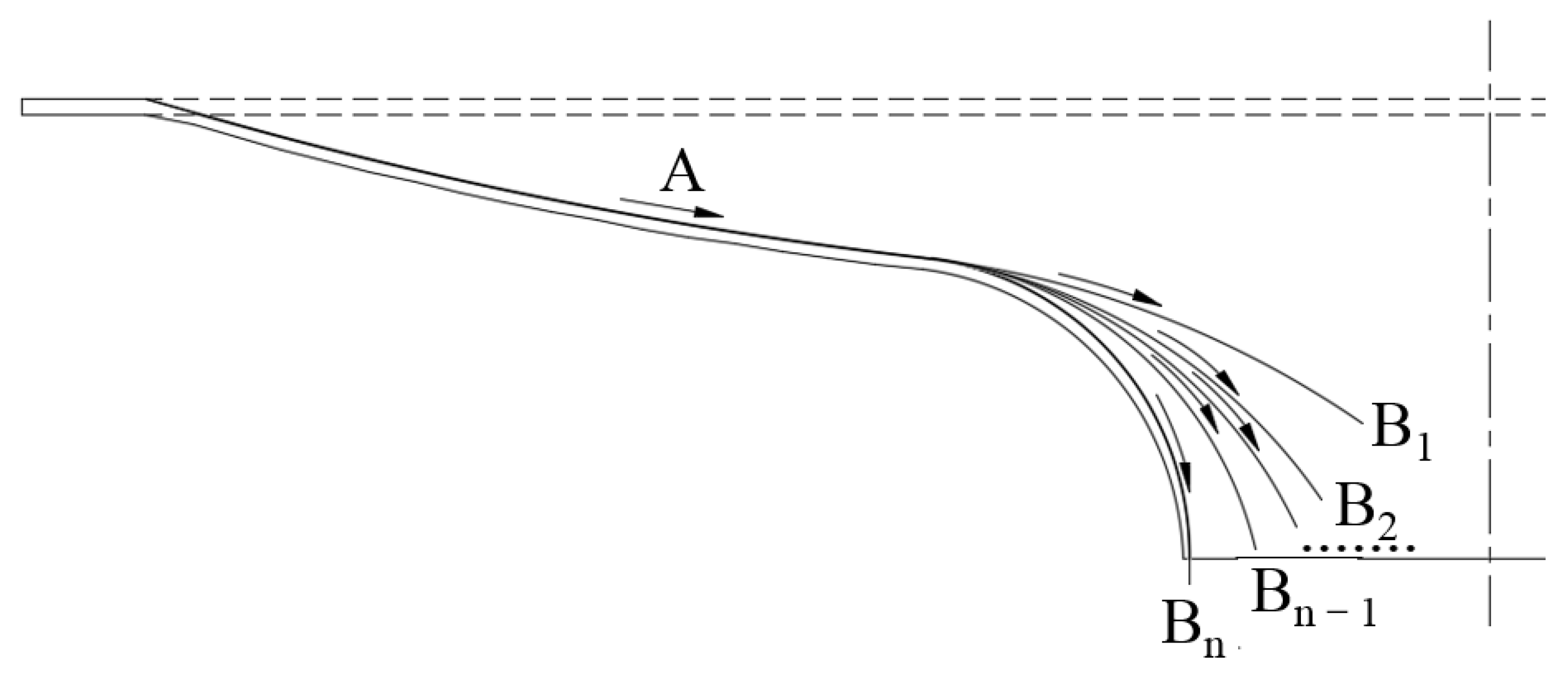
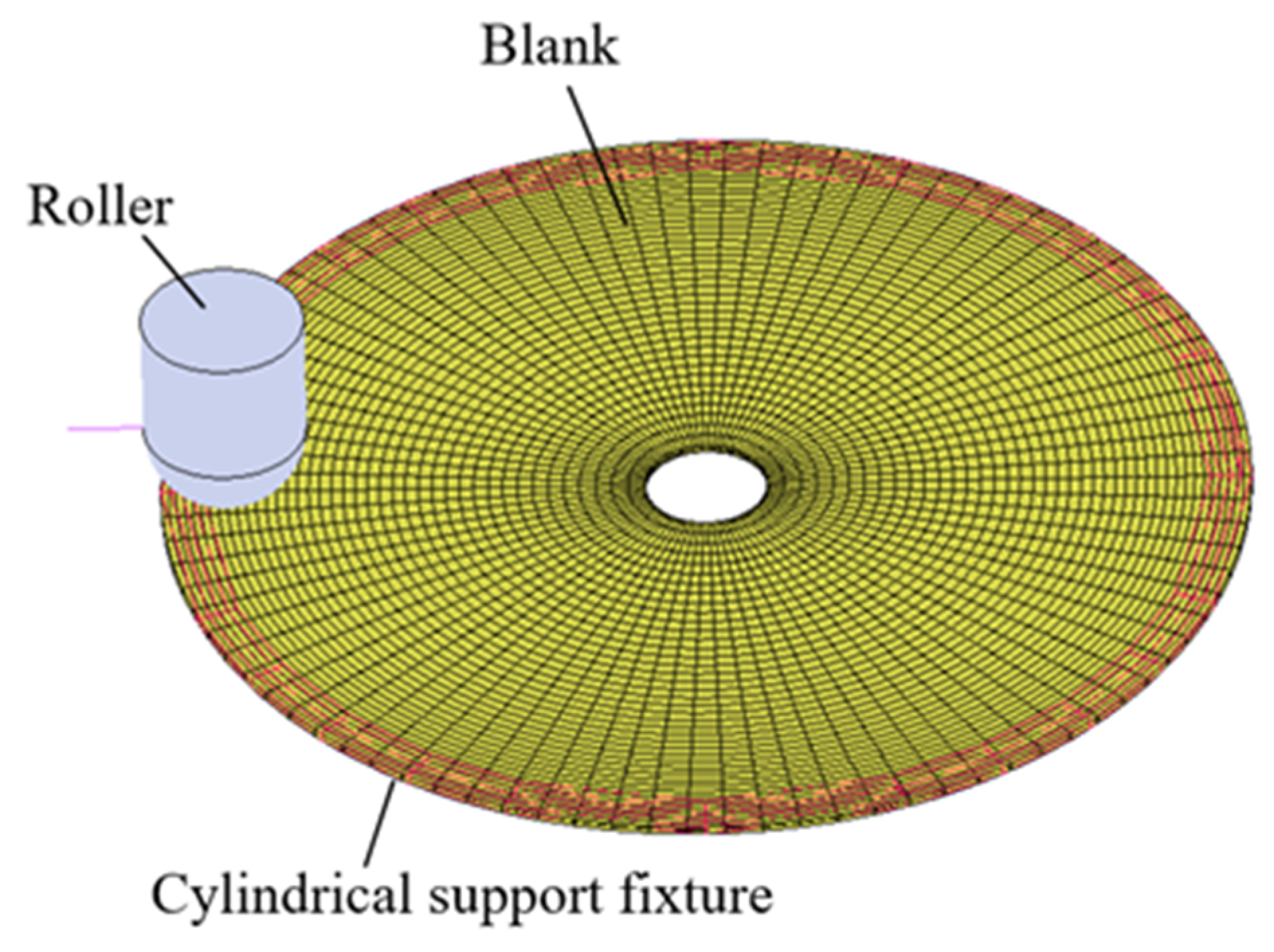

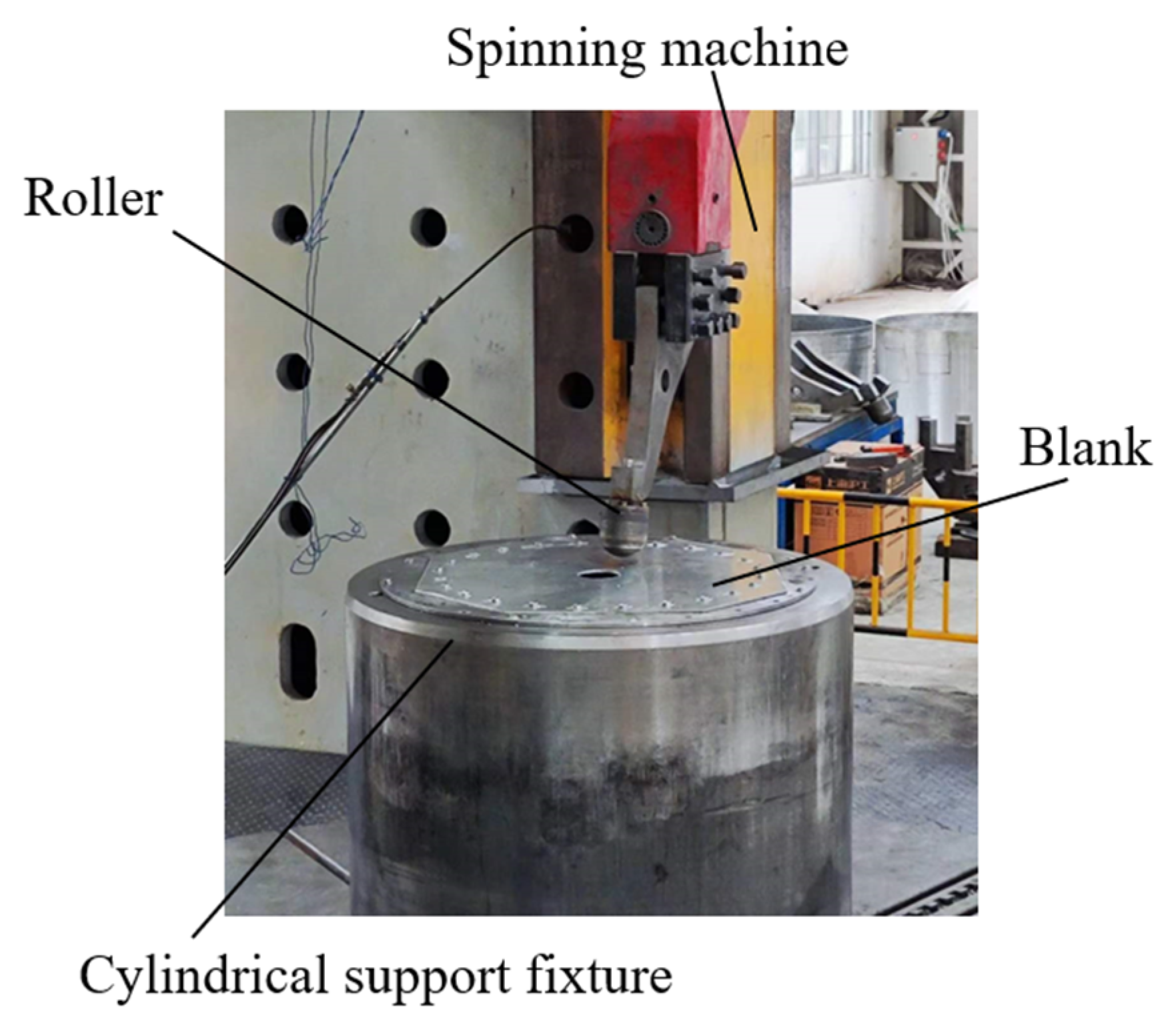


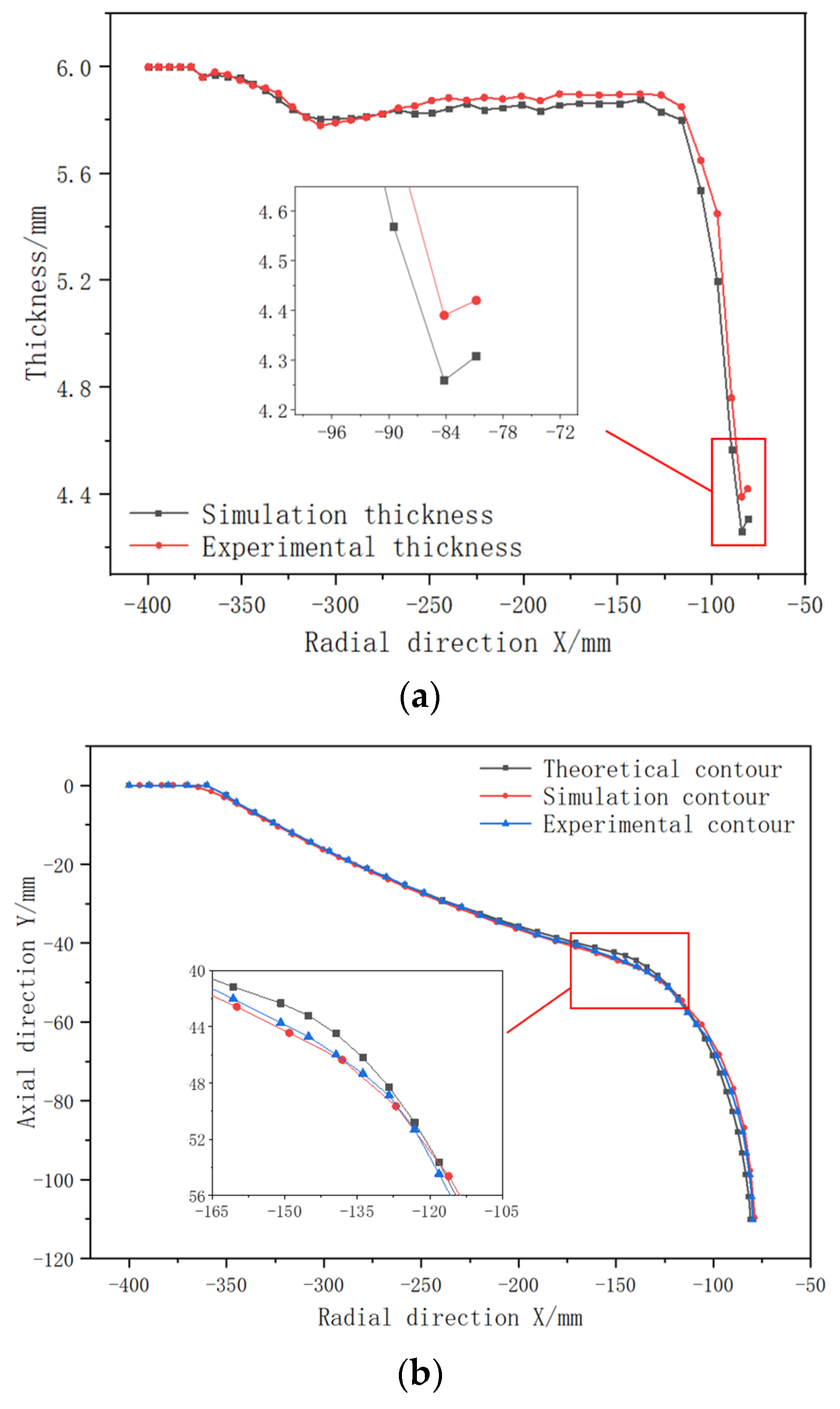



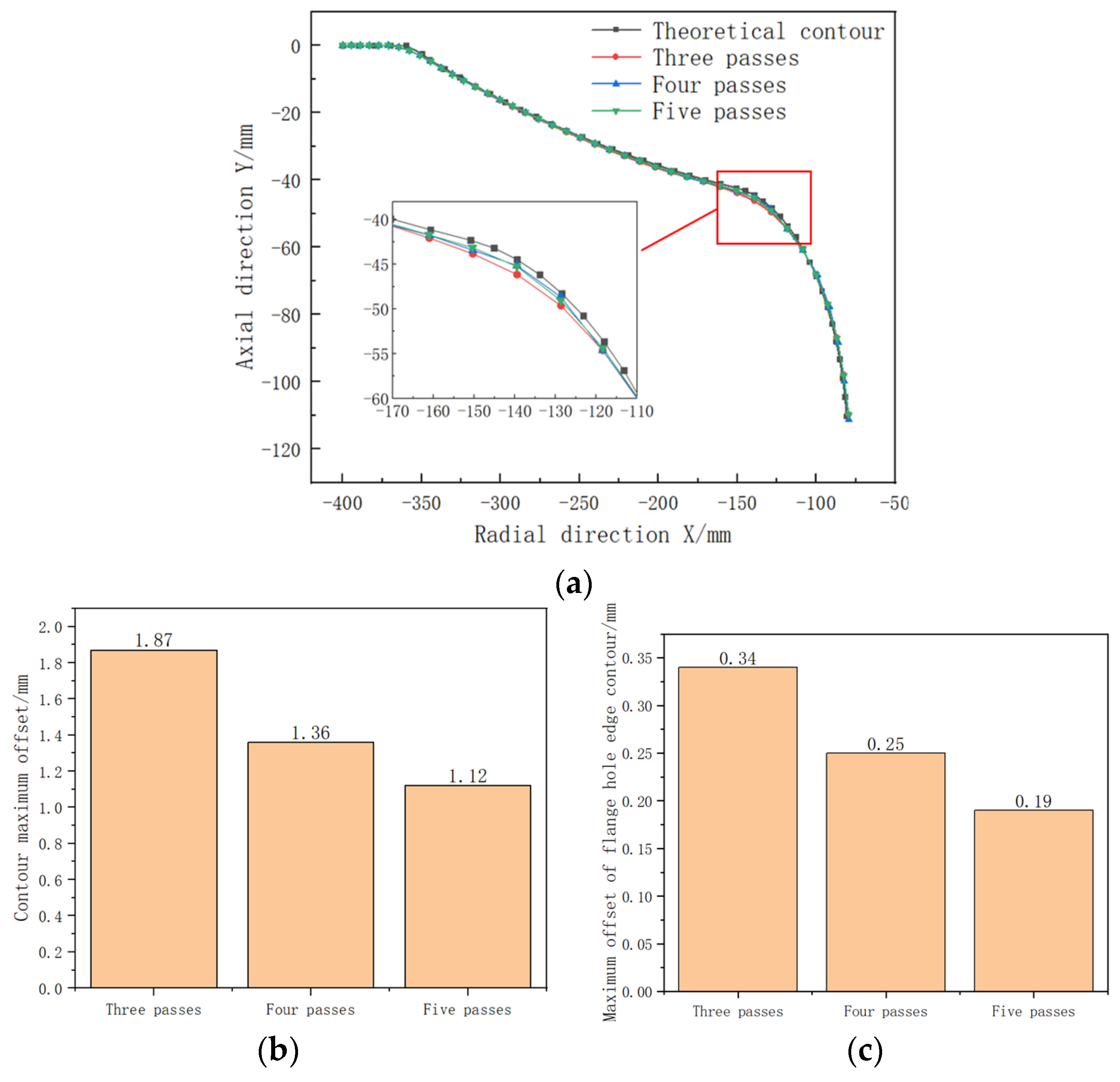
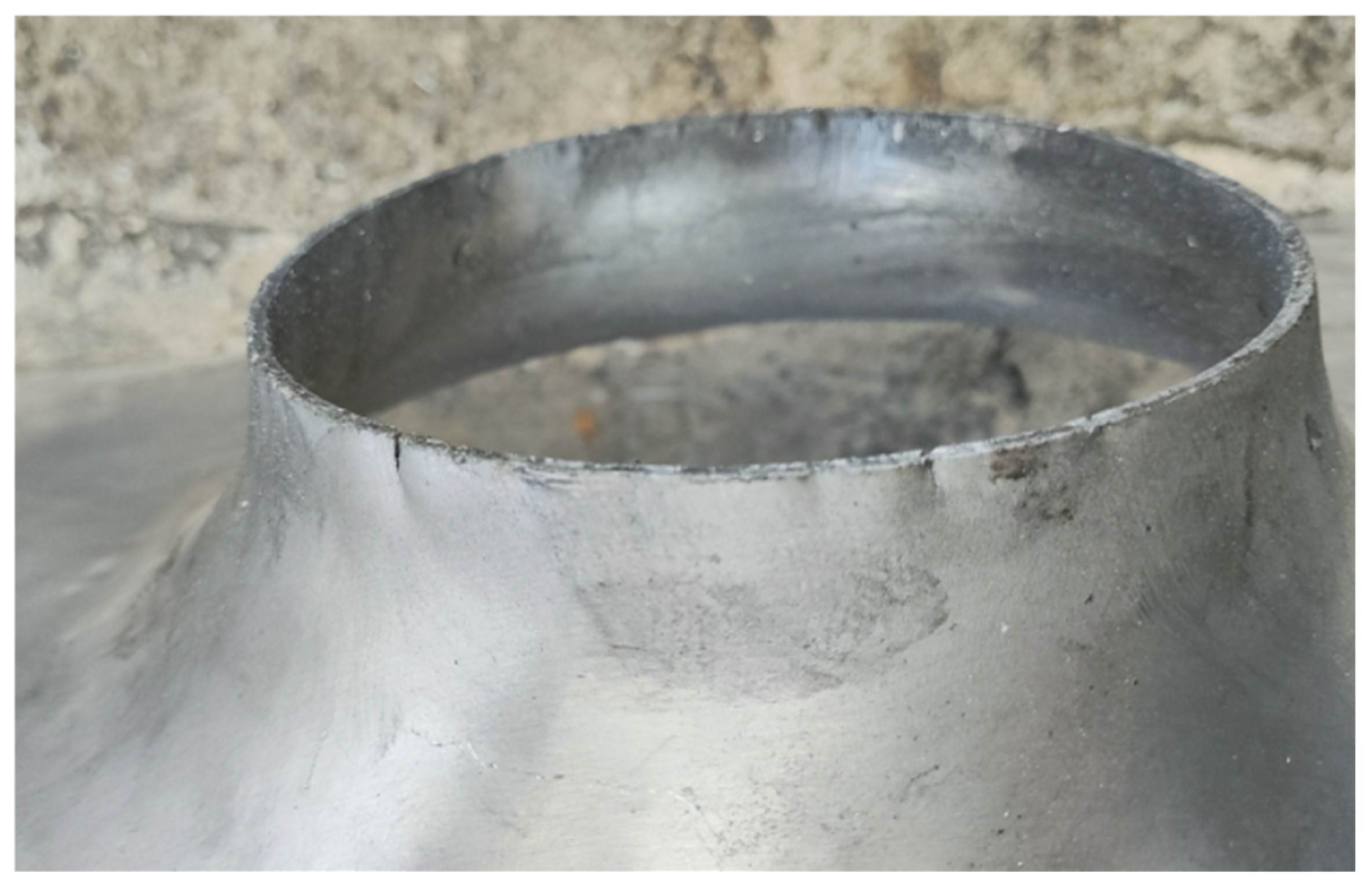

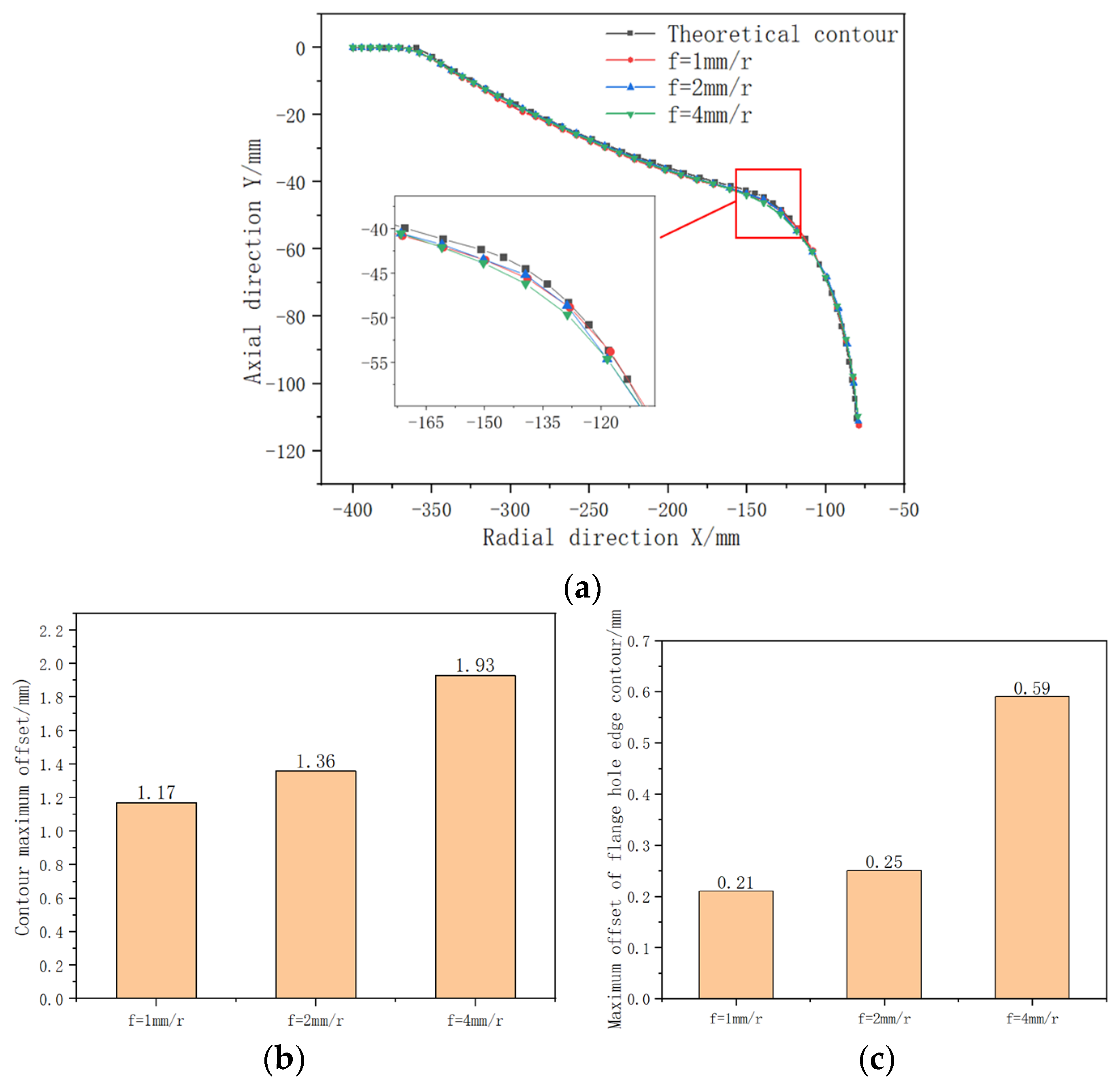


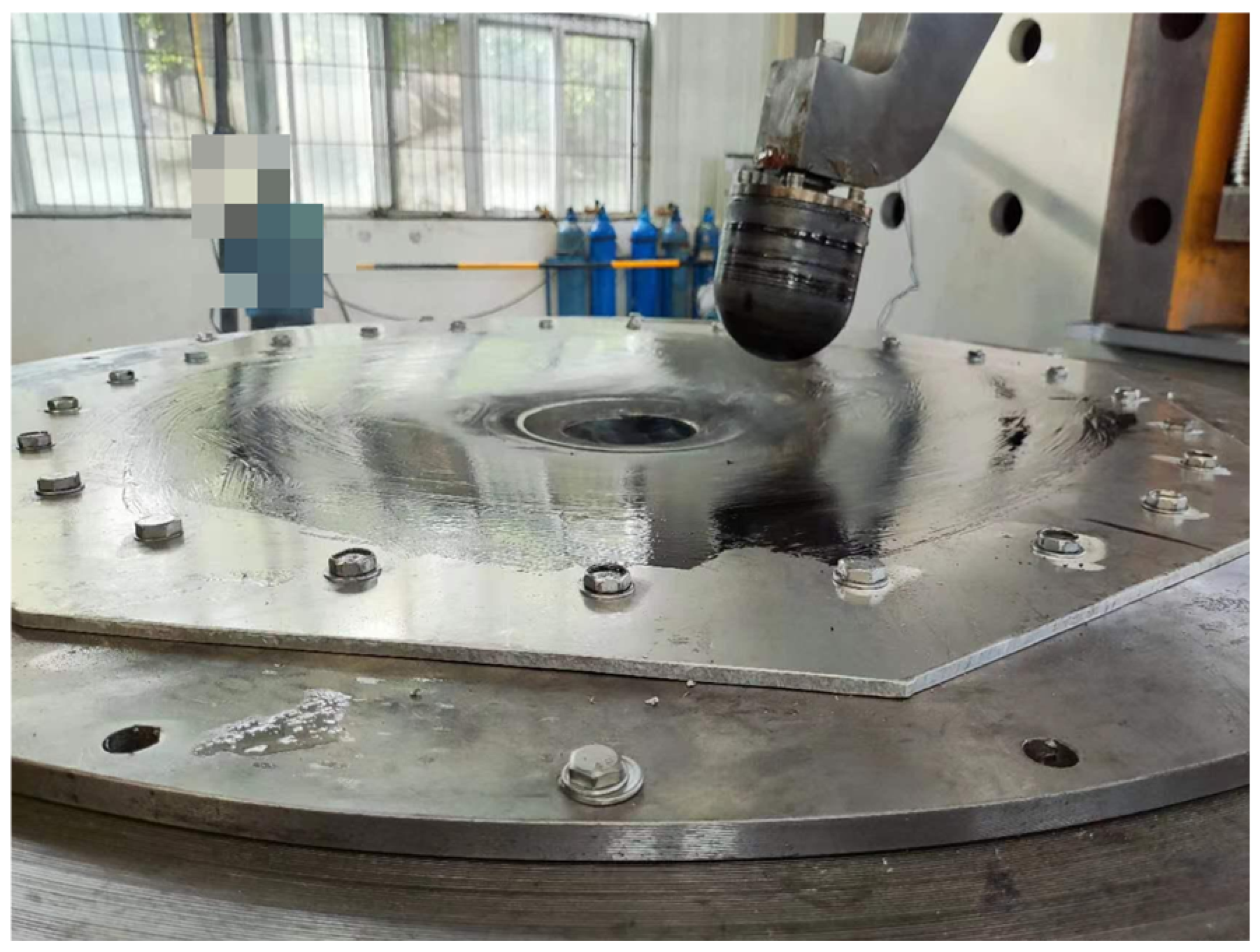
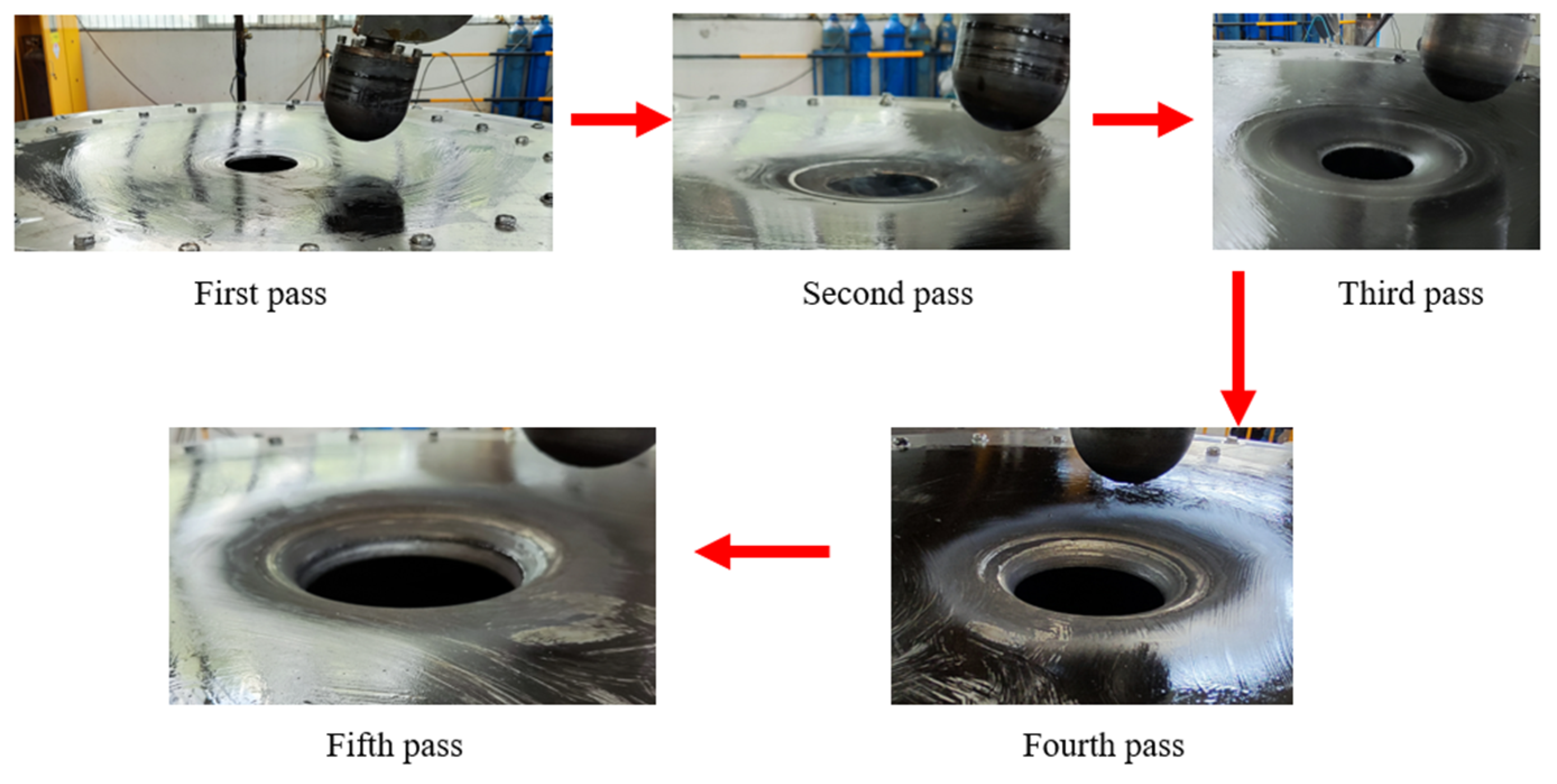


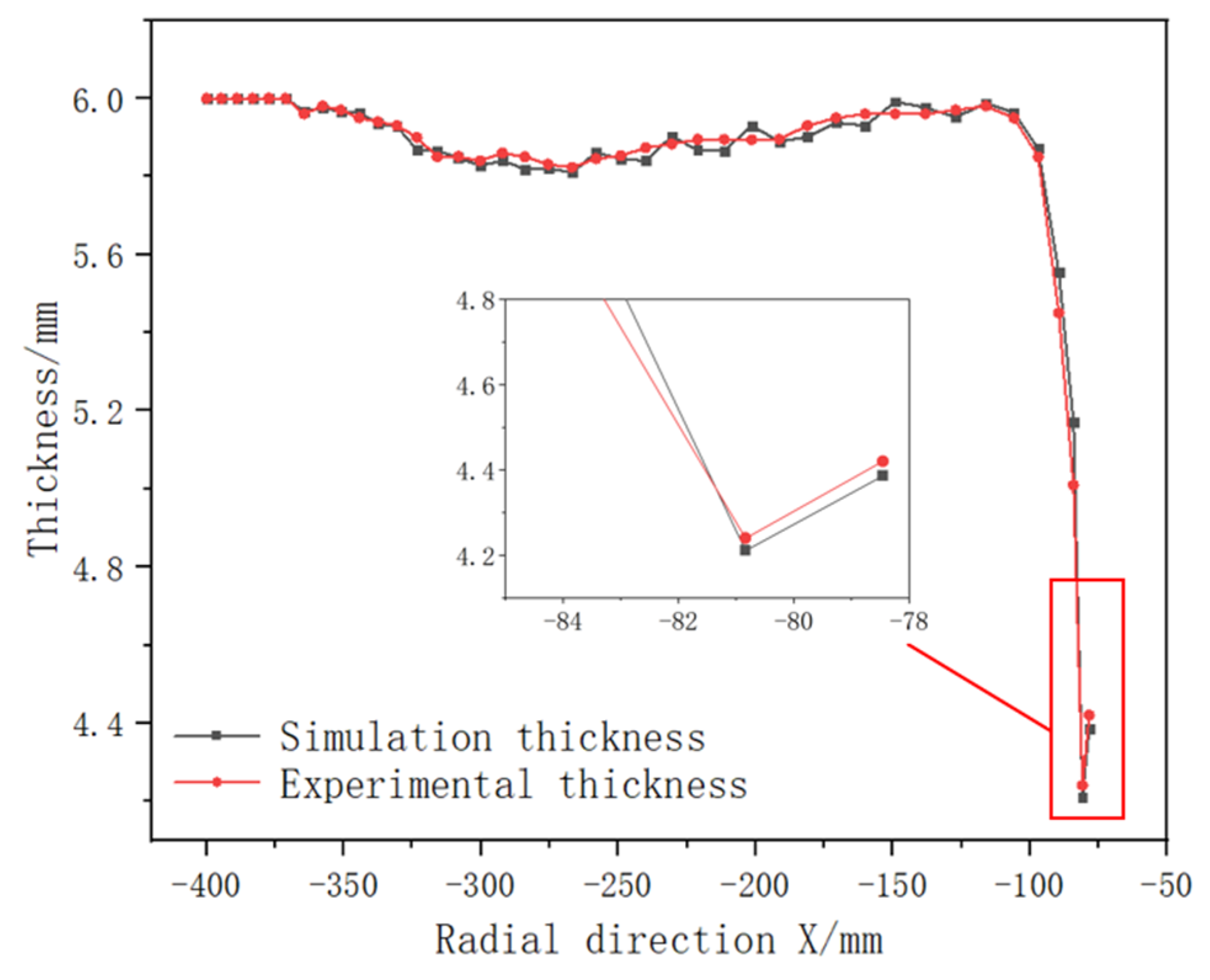

| Option Number | Option 1 | Option 2 | Option 3 |
|---|---|---|---|
| Forming order | A→B1→B2→…→Bn | B1→B2→…→Bn→A | B1→B2→…→Bn−1→A→Bn |
| Elastic Modulus E/MPa | Poisson’s Ratio μ | Density ρ/(kg·m−3) | Tensile Strength /Mpa | Yield Strength /Mpa | Elongation /% |
|---|---|---|---|---|---|
| 73,100 | 0.33 | 2840 | 179 | 75.8 | 18 |
| Number of Passes | Trajectory Path Radius/mm | Roller Trajectory |
|---|---|---|
| Three passes | R375→R185→R140 |  |
| Four passes | R375→R261→R185→R140 |  |
| Five passes | R375→R261→R185→R151→R140 | 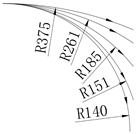 |
Disclaimer/Publisher’s Note: The statements, opinions and data contained in all publications are solely those of the individual author(s) and contributor(s) and not of MDPI and/or the editor(s). MDPI and/or the editor(s) disclaim responsibility for any injury to people or property resulting from any ideas, methods, instructions or products referred to in the content. |
© 2023 by the authors. Licensee MDPI, Basel, Switzerland. This article is an open access article distributed under the terms and conditions of the Creative Commons Attribution (CC BY) license (https://creativecommons.org/licenses/by/4.0/).
Share and Cite
Zhu, L.; Huang, C.; Li, X.; Chang, X.; Yang, J. Process Parameters Optimization of One-Step Spin Forming of Top Cover with Center Flanged Hole. Metals 2023, 13, 1920. https://doi.org/10.3390/met13121920
Zhu L, Huang C, Li X, Chang X, Yang J. Process Parameters Optimization of One-Step Spin Forming of Top Cover with Center Flanged Hole. Metals. 2023; 13(12):1920. https://doi.org/10.3390/met13121920
Chicago/Turabian StyleZhu, Lijun, Cheng Huang, Xinhe Li, Xin Chang, and Jianyong Yang. 2023. "Process Parameters Optimization of One-Step Spin Forming of Top Cover with Center Flanged Hole" Metals 13, no. 12: 1920. https://doi.org/10.3390/met13121920




